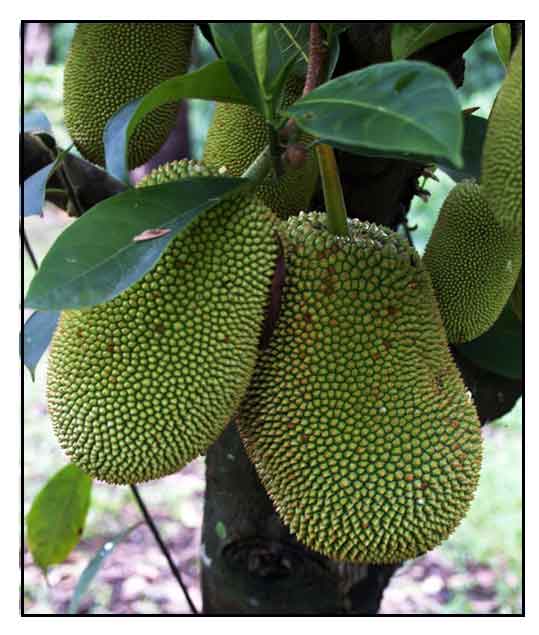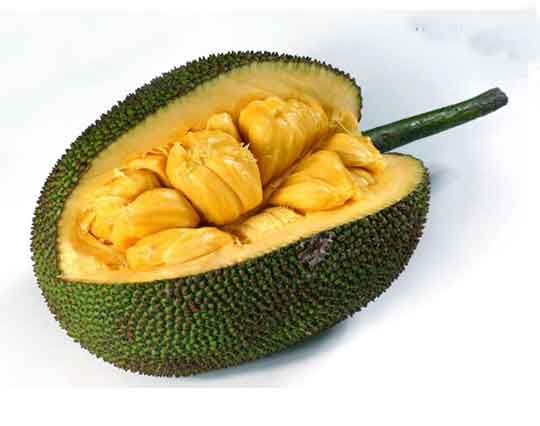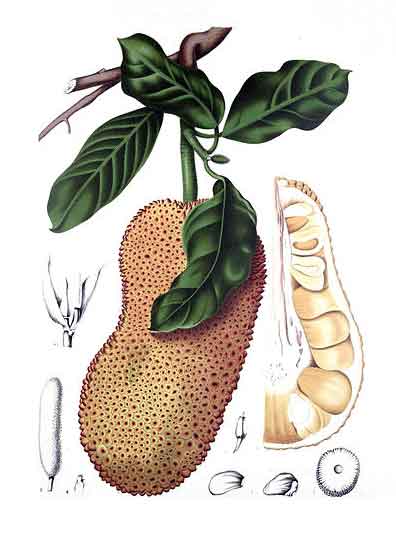 Gen info Gen info
- Artocarpus integer, chempedak or cempedak, is a species of tree in the Moraceae family, in the same genus as breadfruit (rimas) or jackfruit (langka).
- Chempedak is sometimes confused with jackfruit (Langka, Artocarpus heterophyllus). Chempedak is smaller and the peduncle is thinner. Chempedak flesh is darker yellow and juicier when ripe, and odoriferous. (5)
Botany
Artocarpus integer is a large, evergreen tree, growing as high as 20 meters, often less. Bark is grayish-brown. Tree is monoecious, the male and female flowers in the same tree. Leaves are alternate, obovate to elliptic, covered with thin and stiff brown hairs., 5 to 25 centimeters long, 2.5 to 12 centimeters wide. Leaf tips are covered by stipules, also covered with brown hairs. Flowers are borne on solitary stalked inflorescences. Male flowering head is cylindrical, 3.5 to 5 centimeters long and 1 centimeter wide, yellowish-white in color. Fruit is syncarpous, cylindrical to spherical in shape, 10 to 15 centimeters across, 20 to 35 centimeters long. Skin is thin and leathery, greening, yellowish to brownish in color, patterned with pentagonal raised protuberances or flat eye facets. Seeds are large, surrounded by fleshy, edible arils. Arils are yellowish-white to orange in color, sweet and fragrant, slippery on slimy on the tongue. Fruit when ripe has a pungent, harsh, and penetrating smell similar to durian. Seeds are edible flattened spheres or elongated, 2 to 3 centimeters in length. (5)
D istribution istribution
- Introduced.
- Widely cultivated in Thailand, Indonesia and the Malay Peninsula.
Constituents
- Study of leaves for secondary metabolites using a chloroform solvent yielded alkaloids with absence of flavonoids, glycosides, tannins, terpenoids, and steroids. (11)
- Nutrient analysis per 100 gm: energy 117.0 Kcal, water 66.7 g, protein 2.5 g, fat 0.4 g, carbohydrates 25.8 g, fiber 3.4 g, calcium 40.0 mg,
phosphorus 5.0 mg, iron 11 mg, vitamin C 17.7 mg, carotene 80 µg, vitamin B1 0.16 mg, vitamin B2 0.15 mg, niacin 0.5 mg, (13)
- Seed composition based on dry weight (100g) approximately yields protein 10-13%, fat 0.5-1.5%, carbohydrate 77-81%, fiber 4-6%, and ash 3-4%. Water content (fresh) is 46-78%. Number of seeds per fruit varies from 14-131, with total seed weight per fruit of 65-880g, and weight per seed from 1-12 g.
(14)
- Antimalarial activity-guided study of aerial parts of Artocarpus integer isolated a prenylated stilbene, trans-4-(3-methyl-E-but-1-enyl)-3,5,2',4'-tetrahydroxystilbene, along with known stilbenes, trans-4-isopentenyl-3,5,2',4'-tetrahydroxystilbene and 4-methoxy-2,2-dimethyl-6-(2-(2,4-dihydroxy)phenyl-trans-ethenyl)chromene. (see study below) (15)
- Study of chloroform extract of leaves for secondary metabolites yielded alkaloids with absence of glycosides, tannins, terpenoids, and steroids. (20)
- Study of ethanolic and methanolic extract of peels yielded alkaloids, flavonoids, carbohydrates, proteins and triterpenoids. GC-MS analysis yielded secondary metabolites like hexadecanoic acid, squalene, calophyllolide, thialisopyrine, among others. Nuclear Mass Resonance Spectroscopy showed presence of alkyl group and carbon bearing OH group compounds. Atomic Absorption Spectroscopy yielded presence of major minerals like calcium, potassium, and other minor minerals. (21)
Properties
- Pulp of the fruit is slimy and odoriferous, similar to durian. Flavor is sweet, resembling mango and durian. (5)
- Fruits have a short shelf-life of 2 to 3 days. (5)
- Studies have suggested antioxidant, antibacterial, anti-inflammatory, antimalarial . adsorbent , prebiotic, proteolytic properties.
Parts used
Fruit, roots.
Uses
Edibility
- Fruit is edible, eaten fresh or fried with flour, or made into pudding. (5)
-
Fruit pulp is odoriferous, like durian. (5)
- Unripe fruit is eaten as vegetable.
- Ripe seeds are edible; roasted or boiled.
(5)
- Like durian, the smell and taste of the fruit can be overwhelming. To the uninitiated, dishes made from seeds is easier and palatable introduction. (14)
Folkloric
- No reported folkloric medicinal use in the Philippines.
Others
- Wood: Strong and durable; used as material for building furniture or boats.
(5)
- Fiber: Fibrous bark used to make ropes.
(5)
- Dye: Wood yields a yellow dye. (5)
- Latex: Bark yields a latex used in the preparation of lime.
Studies
• Anti-Inflammatory / Flavonoids / Bark: Artocarpus integer var. silvestris Comer is the putative relative of A. integer (Cempedak).Study of bark isolated a new pyranoflavone, methoxycyclocommunol (1) along with four known flavonoids, artonin F (2), heteroflavanone A (3), cudraflavone C (4) and cyclocommunol (5). The pure compounds were evaluated for anti-inflammatory activity, In a 15-lipoxygenase (15-LOX) inhibitory assay, compounds 1, 3, and 4 showed strong dose-dependent inhibition towards prostaglandin E2 (PGE2) production in lipopolysaccharde-induced human whole blood using radioimmunoassay method. IC50s of 4.3, 0.8 and 0.07 µg, respectively suggested strong COX-2 activity. (4)
• Cellulose from Waste: Jackfruit peel is among the underutilized waste materials. Study reports on the extraction of cellulose from de-pectinated peel. The yield of jackfruit cellulose was 27g/100g of dry matter. Bulk, true densities, and carr's index of cellulose were 0.17 g/ml, 0.005 g/ml and 10.561%, respectively. Results suggest jackfruit peel has potential as source of natural cellulose and compares favorably with commercial grade cellulose used for food, pharmaceutical,, and cosmetic applications. (6) Cellulose from Waste: Jackfruit peel is among the underutilized waste materials. Study reports on the extraction of cellulose from de-pectinated peel. The yield of jackfruit cellulose was 27g/100g of dry matter. Bulk, true densities, and carr's index of cellulose were 0.17 g/ml, 0.005 g/ml and 10.561%, respectively. Results suggest jackfruit peel has potential as source of natural cellulose and compares favorably with commercial grade cellulose used for food, pharmaceutical,, and cosmetic applications. (6)
• Effect of Drying Temperatures on Chemical and Antioxidant Properties: The fermented inner skin of cempedak (A. integer) may be used as industrial ingredient while maintaining its antioxidative capacity. Study investigated the effect of temperature on yield, chemical properties and antioxidant activity of starter induced fermented mandai powder. Antioxidant capacity was measured by DPPH assay. There was a strong correlation between TPC, HTC, TFC, and antioxidant capacity. Drying temperature affected all observed parameters except for pH and ash. Temperature of 45°C was the best for production of mandai powder. Antioxidant capacity was contributed to by phenolic components. (7)
• Antibacterial / Stem Bark: Study evaluated the antibacterial activity of n-hexane, chloroform, and methanol fractions of A. integer stem bark. All the fractions yielded terpenoid and steroid compounds. The three fractions inhibited the growth of E. coli and S. aureus using agar diffusion method. The chloroform fraction showed highest activity with inhibition areas of 10.8 and 10.4 mm, respectively. (8)
• Artocarpin / Antibacterial / Roots: Artocarpin is an isoprenyl flavone from Artocarpus species. Artocarpin from the roots of A. integer displayed antibacterial properties, inhibiting the growth of Staphylococcus epidermis, S. aureus, and Propionibacterium acnes with MICs of 4, 2, and 2 µg/ml, respectively. In another study, artocarpin inhibited methicillin-resistant S. aureus (MRSA) and E coli, both with MICs 62.5 mg/ml) and P. aeruginosa with MIC 250 mg/ml. Artocarpin also showed synergistic effects with norfloxacin against MRSA, P. aeruginosa and E. coli. (8)
• Glycemic Index of Bread Substituted with Chempedak Seed Flour: In vitro starch hydrolysis was done to evaluate the hydrolysis index (HI) and estimated glycemic index (EGI) of bread substituted with different levels of chempedak (Artocarpus integer) seed flour (CSF). Bread of 30% CSF exhibited significantly lower (p<0.05) in vitro starch hydrolysis. The HI value decreased significantly (p<0.05) as levels of CSF substitution increased. Resistant starch content in bread samples were inversely related with HI value as CSF substitution levels increase, thus lowering the estimated glycemic index. (12)
• Potent Odorants in Fruit: AEDA (aroma extract dilution analysis) combined with GC-O (gas chromatography-olfactometry) and GC-MS studies evaluated the aroma-impact compounds in two cultivars of chempedak fruit grown in Thailand, Tongtapan and Sainumpung. Based on sensory evaluation, 3-methylbutanol, octanal, and 2-acetyl-1-pyrroline were important odorants in the overall aromas of both cultivars, while ethyl-3-methylbutanoate was an additional key odorant in the aroma of the Tongtapan cultivar. (13)
• Antimalarial / Stilbene / Aerial Parts: Antimalarial activity-guided study of aerial parts of Artocarpus integer isolated a prenylated stilbene, trans-4-(3-methyl-E-but-1-enyl)-3,5,2',4'-tetrahydroxystilbene with an EC50 of 1.7 micrograms/ml against Plasmodium falcifarum in culture. (see constituents above) (15)
• Purification of Leaf Protease: Protease in Artocarpus leaves are traditionally used as meat tenderizer. Study reports on the isolation of a cysteine protease and a purification method, which yielded a preparation with a 12-fold increase in enzyme purity and a final specific activity of 76.67 U/mg. The characteristics of this protease was very different from other plant proteases.(16)
• Optimized Extraction of Pectin / Industrial Waste: Study reports on the optimized extraction and characterization of pectin from Artocarpus integer waste. Pectin isolated from jackfruit wastes can be classified as low methoxyl protein with promising applications in low sugar products.(17)
• Green Activated Carbon / Adsorbent / Industrial Fruit Processing Waste: Study reports on the Artocarpus integer agro-industrial residue conversion into a novel green-activated carbon. The newly activated carbon is of high quality with a large iodine adsorption capacity of 1411 mg/g. The activated carbon may be used as a cleaner )and ecologically compatible industrial adsorbent. (18)
• Prebiotics / Seeds: Prebiotics have significant physiological functions and health benefits, containing non-digestible compounds that affect the growth and activity of bacteria in the host gastrointestinal tract. promoting a healthy digestive system and prevent disease. Study evaluated the potential prebiotic activity of bioactive compounds extract from the seeds of A. integer. The extract. supported the growth of prebiotics such as L. acidophilus and L. casei. Study contributes to the development of underutilized plants plants and identification of new sources of prebiotic materials to be used in food. (19)
Availability
Wild-crafted.
Cultivated
|

![]()





 Cellulose from Waste: Jackfruit peel is among the underutilized waste materials. Study reports on the extraction of cellulose from de-pectinated peel. The yield of jackfruit cellulose was 27g/100g of dry matter. Bulk, true densities, and carr's index of cellulose were 0.17 g/ml, 0.005 g/ml and 10.561%, respectively. Results suggest jackfruit peel has potential as source of natural cellulose and compares favorably with commercial grade cellulose used for food, pharmaceutical,, and cosmetic applications. (
Cellulose from Waste: Jackfruit peel is among the underutilized waste materials. Study reports on the extraction of cellulose from de-pectinated peel. The yield of jackfruit cellulose was 27g/100g of dry matter. Bulk, true densities, and carr's index of cellulose were 0.17 g/ml, 0.005 g/ml and 10.561%, respectively. Results suggest jackfruit peel has potential as source of natural cellulose and compares favorably with commercial grade cellulose used for food, pharmaceutical,, and cosmetic applications. (